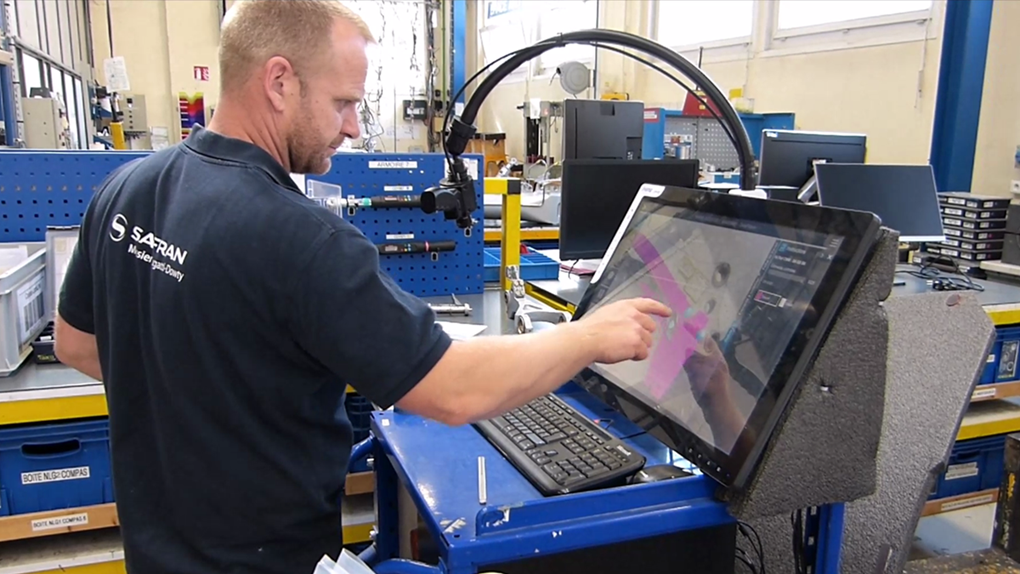Safran Landing Systems
Safran Landing Systems improves the efficiency and quality of MRO activities using DELMIA Augmented Experience.
The real value of these solutions have been confirmed with our operators and inspectors in terms of quality, productivity and work ergonomics, and are now used on a daily basis for many use cases. Building on this success, we at Safran Landing Systems have initiated a deployment plan in all of our repair sites around the world.
The Story
The maintenance of aeronautical equipment is carried out according to specific rules and processes as defined in the maintenance manuals provided by the manufacturers.
However, this regulatory documentation detailing the official repair procedures cannot be used directly by the operators: indeed it requires an interpretation which involves experience and time, especially since the equipment arriving in the workshops is of varying configurations. Added to this is the very time-consuming preparation of intervention reports required by the regulations.
In order to improve efficiency and guarantee optimum quality of its procedures, Safran Landing Systems uses DELMIA Augmented Experience for most of the stages of the repair process. Focus on the implementation and the gains obtained on some of the key stages of the MRO process.
Inspection and Repair: Regulatory documentation requiring an effort of interpretation and a high level of expertise of the operator
The MRO process is not repetitive. It leads to the application of work instructions very dependent on the configuration of the products arriving for repair: products with a long lifespan (up to 30 or 40 years) having undergone multiple technical modifications in operation, configuration to be reassembled according to the modifications requested by the customer… each general overhaul carried out every 10 years is a specific case.
In this context, fully contextualized work instructions in relation to the configuration of the product to be repaired and the configuration to be delivered after repair are necessary to guarantee compliance with airworthiness requirements and ensure the expected level of quality. The interpretation of this regulatory documentation by the operator represents a particularly important interpretive effort, even when the operator is experienced.
This is why Safran Landing Systems sought to simplify the application of maintenance manuals and reduce the operator’s mental burden.
The objective: to ensure the use of the appropriate work instructions for the configuration of the landing gear to be delivered and thereby contribute to the highest operational excellence.
To do this, the operator is now guided by digital instructions at each step, using DELMIA’s Augmented Experience assisted inspection capability. Overlaying 3D models for critical and complex tasks allows adaptation to the operator’s level of expertise through a simplified expression of assembly or inspection operations. The level of assistance is more or less detailed depending on the experience of the operator, from beginner to expert, thereby optimizing the learning curve while improving versatility in the repair shop, a key factor of competitiveness and flexibility in MRO.

Reporting and traceability: Strong requirements to meet
However, the need for burden reduction does not stop with the implementation of regulatory documentation. The MRO process is accompanied by a strong reporting requirement, the content of which varies depending on the product repaired and the customer concerned. Here too, the variability and completeness of the information induces a considerable cognitive load. In addition, this documentation of repair and inspection operations of the product generates a large volume of images and PDF documents to be processed and transmitted to customers.
In this context, the use of digital compliance control instructions also brings a significant improvement. As assembly progresses, the results of the operations of each task up to the measurement or tightening torque reading from connected tools are systematically recorded.
During preliminary inspection or final inspection tasks, pictures taken with the camera with associated inspector comments are automatically exported to a reporting function allowing the final report to be personalized according to the repaired product and client.
DELMIA Augmented Experience introduces effective digital traceability at each key stage. The digital information, associated with the digital model of the product concerned is consolidated in a database to be used subsequently for the purposes of analyzing the in-service behavior of the products.
Results & Benefits
Quality
• Traceability of operations carried out and inspection results
• Reduction of rework (“good at first time”)
• Elimination of non-quality exported on delivery to customers
• Quality of reports to clients
• More efficient inspection and diagnostic process
• Facilitated exploitation of data collected in repair to analyze the behavior of the product in operation thanks to digital
Productivity
• Shorter execution time
• Optimization of learning curves for beginners
• Increased flexibility in workshop
• Simplification of the tasks of updating digital work instructions
• Automation of the production of quality reports activity
Ergonomics
• Solution integrated into the user work environment
• Operators refocused on their expertise, freed from the mental burden of documentary research
Discover more about the Keep Them Operating industry solution experience.

Focus on Safran
Safran is an international high-technology group, operating in the aviation (propulsion, equipment and interiors), defense and space markets.
For more information: https://www.safran-group.com/companies/safran-landing-systems

